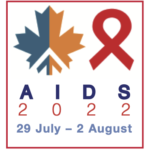Dolutegravir no longer linked to higher risk of neural tube defects: latest update from the Tsepamo study
1 September 2022. Related: Conference reports, Pregnancy, World AIDS 24 Montreal 2022.
Polly Clayden, HIV i-Base
 The prevalence of neural tube defects (NTDs) among infants born to women receiving dolutegravir (DTG) at conception has declined slightly to 0.11% and is not substantially different from those exposed to other antiretrovirals. [1]
The prevalence of neural tube defects (NTDs) among infants born to women receiving dolutegravir (DTG) at conception has declined slightly to 0.11% and is not substantially different from those exposed to other antiretrovirals. [1]
These reassuring findings from the Tsepamo study, Botswana were presented at AIDS 2020.
Botswana started using DTG-based first-line ART in 2016. In May 2018 the Tsepamo study first reported a possible association between NTDs and exposure to DTG from conception. Since then, yearly updates from the study have shown a steady decline in risk with additional documented exposures.
We have covered Tsepamo and this potential safety signal extensively in HTB – including study methodology and commentary. [2, 3, 4] As a quick recap:
- Original signal, May 2018: 0.94 NTDs with conception DTG exposure (n=426) vs 0.12% with other ART exposure groups (n=11,300)
- Last update, March 2021: 0.15% with conception DTG exposure (n=5,860) vs 0.1% with other ART exposure groups (n=22, 475)
- Data presented at AIDS 2020, as a late breaker poster described here, were collected through March 2022.
Overall, between 15 August 2014 and 31 March 2022, there were 224,251 deliveries at study sites and 223,797 (99.8%) had an evaluable infant surface exam.
Of these, 9,460 were exposed to DTG from conception; 23,664 were exposed to non-DTG ART (14,432 efavirenz); 6,551 started DTG in pregnancy and 170,723 were among women without HIV.
Since March 2021, 32,819 additional births were recorded, including 3,600 more DTG conception exposures. The authors identified 16 additional NTDs: 1 with DTG conception exposure; 3 with non-DTG conception exposure; 1 with DTG started in pregnancy and 11 among women without HIV.
The additional NTD with DTG conception exposure was anencephaly (the authors noted that there was no available photo).
Across the entire study, since August 2014, there were 156 (0.7%, 95% CI 0.6% to 0.8%) NTDs identified (100 with photo and 56 description only). With DTG conception exposure there were 10 NTDs among 9,460 exposures (0.11%, 95% CI 0.06 to 0.19%).
This compared with non-DTG ART from conception, where there were 25 NTDs among 23,664 exposures (0.11%, 95% CI 0.07 to 0.16%). And with efavirenz from conception, there were 11 NTDs among 14,432 exposures (0.08%; 95% CI 0.04 to 0.14%).
For women who started DTG in pregnancy there were 4 NTDs among 6,551 exposures (0.06%; 95% CI 0.02 to 0.16%). And 108 NTDs out of 170,723 exposures (0.07%; 95% CI 0.05 to 0.08%) among women without HIV.
Table 1. Prevalence difference of neural tube defects by ARV and HIV exposure categories
| Exposure group vs comparison group | Prevalence difference (95%CI) |
| DTG at conception vs non-DTG at conception | 0.00% (–0.07 to +0.10%) |
| DTG at conception vs. EFV at conception | 0.03% (–0.05 to +0.12%) |
| DTG at conception vs DTG started in pregnancy | 0.04% (–0.06 to +0.14%) |
| DTG at conception vs non-DTG started in pregnancy | 0.04% (–0.07 to +0.13%) |
| DTG at conception vs women without HIV | 0.04% (–0.01 to +0.13%) |
The authors concluded that these data support existing WHO guidelines that recommend DTG-based first-line ART for all adults, regardless of reproductive potential.
comment
Following the previous update two years ago, for which the prevalence estimates suggested about one excess NTD per 1000 births with exposure to DTG at conception (with the lower bound of the 95% confidence interval just below or just about zero) we wrote: “Good news that we can finally ‘lay this to rest’ (as remarked at the AIDS 2020 press conference)”.
This further slight decline to 0.11% reported here should surely finally, finally do so.
DTG must now be the most scrutinised antiretroviral for use in pregnancy. The updated Tsepamo data needs to be widely publicised as unfortunately concern about the original safety signal has remained in some settings despite evidence to dispute this.
References
- Zash R et al. Update on neural tube defects with antiretroviral exposure in the Tsepamo Study, Botswana. AIDS 2022. Montreal, Canada. 29 July – 2 August. Poster abstract PELBB02.
https://programme.aids2022.org/Abstract/Abstract/?abstractid=12759 (abstract)
https://conference.aids2022.org/media-2648-update-on-neural-tube-defects-with-antiretroviral-exposure-in-the-tsepamo-study–botswana (poster)
2. Clayden P. Dolutegravir preconception signal: time is up for shoddy surveillance. HTB. 11 July 2018.
https://i-base.info/htb/34459
3. Clayden P. Dolutegravir neural tube defect risk declines but still slightly higher than with other antiretrovirals. HTB. 24 July 2019.
https://i-base.info/htb/36478
4. Clayden P. Neural tube defects in two of 1000 conception exposures with dolutegravir: reassuring update from Tsepamo study. HTB 22 July 2020.
https://i-base.info/htb/38422

